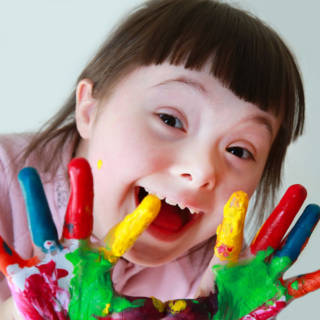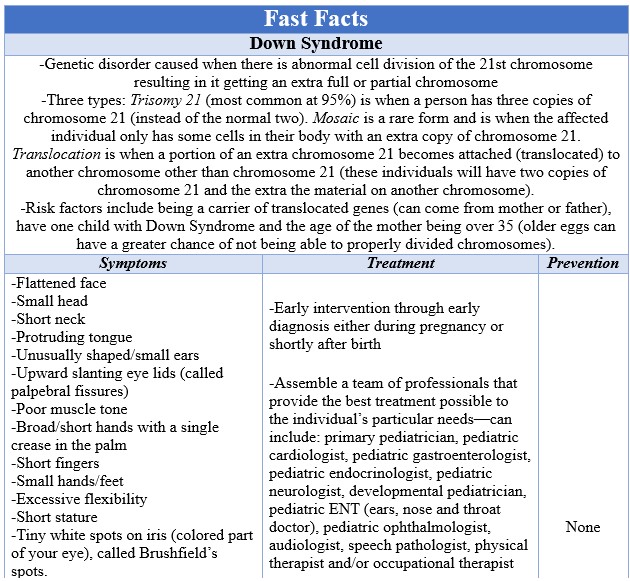What is the cause?
With the new Gerber baby being a cute little boy who has Down Syndrome, it has probably caused many more people to think about what is it? What challenges does it present? Are those affected by it able to live a good quality life?
 Definition
Definition
Down Syndrome is a genetic disorder that is caused when there is abnormal cell division of the 21st chromosome. Every human cell has 23 pairs of chromosomes (one in each pair comes from each parent). In Down Syndrome, the abnormal cell division occurs at some point during reproduction and results in chromosome 21 getting an extra full or partial chromosome. The most common (95%) is Trisomy 21, which is when a person has three copies of chromosome 21, instead of the normal two. This is typically from abnormal cell division when either the egg or sperm is being created prior to fertilization. Mosaic is a rare form and is when the affected individual only has some cells in their body with an extra copy of chromosome 21. This is caused by abnormal cell division after fertilization. The third type is Translocation and is when a portion of an extra chromosome 21 becomes attached (translocated) to another chromosome other than chromosome 21. Typically, these individuals will have two copies of chromosome 21 and the extra the material on another chromosome. This process can occur prior to or at conception. Despite being a genetic disorder, it is not inherited from parent to child, unless translocation, but is abnormality of cell division that can present in anyone. Risk factors that can lead to an individual having Down Syndrome are being a carrier of translocated genes (can come from mother or father), have one child with Down Syndrome and/or the age of the mother being over 35 (older eggs can have a greater chance of not being able to properly divided chromosomes).
Symptoms can vary for each individual, but there are some common traits that are classified specifically to Down Syndrome. They typically have apparent facial features, but each person doesn’t necessarily have all the features (everyone is different). These features can be a flattened face, small head, short neck, protruding tongue, unusually shaped/small ears and upward slanting eye lids (called palpebral fissures). They also tend to have poor muscle tone, broad/short hands with a single crease in the palm, short fingers, small hands/feet, excessive flexibility, short stature and tiny white spots on iris (colored part of your eye), called Brushfield’s spots. As far as cognitive functioning, most have mild to moderate impairment with delays in speech and the ability to process language. These individuals usually have challenges with short-term and long-term memory. In addition to these symptoms, people with Down Syndrome also usually have other medical conditions that are related to the disorder that they are born with and gets worse with age. Some of these include heart problems, gastrointestinal problems, immune disorders, obesity, spinal problems, sleep apnea, dementia and leukemia.
Treatment
Treatment for Down Syndrome is unique for each individual depending on their needs. The key is early intervention. In order to achieve this, there are several ways to diagnose it. There are screenings that can be done during pregnancy, such as blood work and ultrasounds, done at various stages. Pregnancy-Associated Plasma Protein-A (PAPP-A) and Human Chorionic Gonadotropin (HCG) are blood tests done during the first trimester. Nuchal Translucency ultrasound is also completed during the first trimester. In addition, doctors can order a quad panel (alpha fetoprotein, estriol, HCG and inhibin A) during the second trimester. Other tests, such as Chorionic Villus Sampling (taking a sample of cells from the placenta) or Amniocentesis (sample of the amniotic fluid), can be completed at appropriate times during pregnancy. Both of these procedures are very low risk for miscarriage. Typically, after birth, a diagnosis is made based on appearance of the child, but a blood test called chromosomal karyotype is completed to confirm it.
Once the diagnosis is made, it is important to assemble a team of professionals that will be able to provide the needed intervention. This team includes the primary pediatrician and any specialists that are needed, such as pediatric cardiologist, pediatric gastroenterologist, pediatric endocrinologist, pediatric neurologist, developmental pediatrician, pediatric ENT (ears, nose and throat doctor), pediatric ophthalmologist, audiologist, speech pathologist, physical therapist and/or occupational therapist. The most essential thing to remember is to put together a team that you trust in providing the best care possible for your child. Part of the process of early intervention is to find programs in your area that offer assistance in doing this and learn about educational opportunities. It can be beneficial to find families going through a similar situation to have a support group. For the individual, include them in social and leisure activities. While some adaptions may be needed, they profit greatly from participating. As an individual matures, it is vital to encourage independence and plan for a transition to adulthood. Since the current life expectancy of a Down Syndrome individual is 60-years-old, planning is essential. Most of the time, individuals are able to live with their families, go to mainstream schools and participate in the community, such as getting a job when old/mature enough with minimal to moderate support.
Prevention
As of now, there is no way to prevent Down Syndrome. Prenatal counseling is recommended for everyone. This is especially true if you carry the trait for Translocation or already have a child with Down Syndrome. By doing this, you will be able to prepare ahead of time if your child is diagnosed.
While having a child diagnosed with Down Syndrome can come as a shock and presents a unique set of challenges, most of these individuals are some of sweetest, kindest and lovable people. If you have any questions or concerns about Down Syndrome, please speak with your doctor. If you would like more information, please visit the National Down Syndrome Society at https://www.ndss.org/